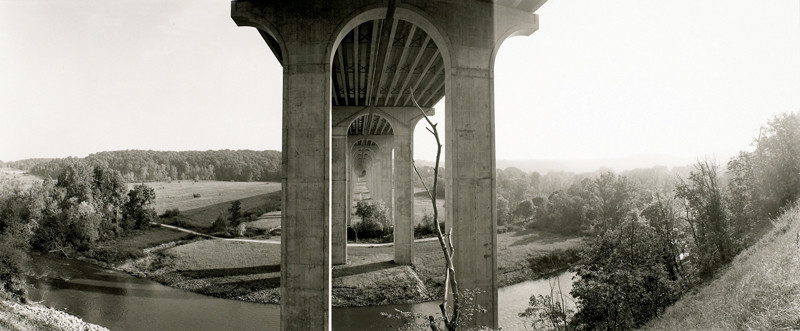[Fall 2008]
National Gallery of Canada
May 30 – October 19, 2008
Geoffrey James describes his photographs as the outcome of “walks with purpose.” His approach is both methodically and philosophically in opposition to the wanderings ascribed to other photographers interested in the landscape and in urban environments, who trust in happening upon inspiration in their journeys. Capitalizing on the evocative abilities of place, James instead strides toward his subject matter, presenting the viewer with arresting images of the vestiges and adaptations that the human presence has wrought upon built environments and the implications that these looming footprints, traffic, and shadows play out upon the natural world.
Utopia/Dystopia is a major retrospective of James’s photographic ruminations from the late 1980s to the present day. Divided into eight thematic sections, the exhibition draws from the full range of formats that the photographer has employed over his career, from the exquisite small-size panoramas that “read” like visual short stories, to large-scale works that halt viewers in their tracks. James’s photographs are gorgeously produced; scale is thoughtfully employed for its ability to draw the viewer in and to address issues around the sublime in the landscape. Moreover, as the exhibition title proposes, James’s imagery explores the complexities of a place between two extremes, underscoring that even an earthly paradise cannot be constructed without wreaking structural and sociological consequences.
In his groups of Panoramas, James has created small, carefully crafted views, each sparking the imagination like poetic verse. Overlooking the Seine in the western suburbs of Paris, the ruins of the Château de Saint-Cloud and the surrounding park have been fertile ground for photographers’ imaginations; Atget’s iconic views spring prominently to mind. That James holds Atget in high esteem rests in the margins of his particular approach to this place; rather than create an image in opposition to deny all traces of the other’s gaze or as a quotation of the previous view, there is here instead a sense of walking alongside another traveller. James’s small gelatine-silver panorama print argues eloquently for the larger project that James has envisioned for himself, that of shared spaces and their collective impact on individuals.
James’s Olmsted photographs represent a seven-year project to create a comprehensive series of images of Frederick Law Olmsted’s landscape designs. Credited with the birth of modern landscape architecture, Olmsted is best known for public spaces such as Central Park in New York City and Mont-Royal in Montreal. Conceived to provide respite to the city dweller, his urban environments share the hallmarks of winding paths, impressive views, and large expanses of open space. His steadfast belief was that these places necessitated public use. The outcome of this enjoyment is of keen visual interest to James – in photographs such as Tree Roots and Rocks, Looking towards The Dakota, Central Park, New York (1993), some of the disentanglement and fraying of Olmsted’s tightly constructed designs is shown for all its ragged beauty.
In another section of the exhibition, James proposes several large-scale photographs of trees, each image tightly cropped in vertical orientation. One seldom looks so closely at a single tree unless it holds some personal significance; moreover, in James’s photographs, almost the entire tree trunk stands squarely at eye level, a vantage point unparalleled in nature. James offers the viewer the luxury of an opportunity to look closely at something commonplace, isolating each tree as a rare object worthy of contemplation.
Running Fence represents some of James’s most political works, although arguably his entire body of photographic work exhibits aspects of social commentary to varying degrees, not only through the subject matter but also through his many approaches to landscape and its societal implications. In works such as Settlement along the Fence, Tijuana (1997), the way in which land is defined, divided, and protected is emblematically rendered by a flimsy, dilapidated expanse of fence with a vast, empty terrain on one side and a densely populated group of houses jutting up again the corrugated metal barrier on the other side. The territorial divide proves to be largely psychological in its purpose; in another image, James exposes for all to see that the fence actually comes to an abrupt end, ultimately throwing its very purpose into sharp, sardonic irony.
Most of the works in the exhibition are in black and white, with the noteworthy exceptions in an ongoing project called 905, marking James’s first series in colour. The title refers to the area code for the ever-growing outlying areas around Toronto; “905” is now almost shorthand for mass urban expansion and its repercussions. In the catalogue that accompanies the exhibition, James posits that the subject matter possessed a vulgarity that “demanded” colour. Indeed, James takes full advantage of the lurid quality of the hues in dye-coupler prints of housing developments and asphalt roadways – an impossibly and oppressively blue sky frames the rooftops of a development in New Housing, North of Highway 7, Toronto, 11 September 2001, with a billboard beckoning prospective occupants, prophetically, to “Buy Before Time Runs Out!”
As a parting image, Untitled, North of Toronto (2003) depicts a boarded-up old home at a crossroads of highways. The farmland surrounding the dwelling, a relic of the area’s agricultural heritage, is now marred by telephone poles and topographical markers along the roadside, foreshadowing the inevitable development projects on the outskirts of the frame. Through James’s lens, we are confronted with the evidence of population and place jutting against one another, each coming away from the experience irrevocably altered.
Johanna Mizgala is a curator and critic based in Ottawa. Her current research includes a study of the first appearances of the subject’s sense of humour in early photographic portraits.


